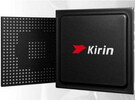HiSilicon Kirin 990 5G vs Qualcomm Snapdragon 865+ (Plus) vs HiSilicon Kirin 820
HiSilicon Kirin 990 5G
► remove from comparison
The HiSilicon Kirin 990 5G is an ARM based high-end octa-core SoC for smartphones and tablets, which was introduced with the Huawei Mate 30 Pro in late 2019. It integrates eight CPU cores in three clusters. The performance cluster contains two Cortex-A76 cores with up to 2.86 GHz, the balanced cluster contains also two Cortex-A76 cores but with only up to 2.36 GHz and finally the power saving cluster contains four small ARM Cortex-A55 cores with up to 1.95 GHz. Furthermore, the SoC integrates a neural processor (2 + 1 cores) for AI tasks and a ARM Mali-G76 MP16 GPU clocked at up to 700 MHz. Compared to the 4G version, the 5G Kirin 990 integrates a Balong 5G modem and is slightly higher clocked (2 of the 3 clusters and the GPU).
The Kirin 990 5G is produced in the modern 7nm (7FF+ with EUV) process at TSMC, the 4G version is still produced in the slightly older 7nm process as the Kirin 980.
Qualcomm Snapdragon 865+ (Plus)
► remove from comparison
The Qualcomm Snapdragon 865+ (Plus) Mobile Platform is a high-end smartphone and tablet SoC that Qualcomm announced in mid 2020. The SoC integrates a fast ‘Prime Core’ that clocks up to 3.1 GHz and three additional ARM Cortex-A77 performance cores, which can reach up to 2.42 GHz. These are complemented by four power-saving ARM Cortex-A55 cores that clock up to a maximum of 1.8 GHz. The difference to the older Snapdragon 865 is the faster clocked Prime Core and 10% higher clocked GPU.
Therefore, the Snapdragon 865 takes the top spot in mobile processors for Android based systems. In some multi-core workloads, the SD865+ can even perform on par with the Apple A13 SoC. Single thread, however is still a strong suit of the Apple SoCs.
Compared to the previous generations, the Snapdragon 865 and 865 Plus does not integrate an LTE modem anymore, but has to be paired with the new X55 5G modem, that also supports LTE Cat 24/22. The Wi-Fi module however is still integrated and called FastConnect 6800 with support for Wi-Fi 6 (802.11ax) and 8x8 MU-MIMU and 60 GHz 802.11ay with up to 10 Gbps. Bluetooth 5.1 is also supported including aptX Adaptive.
The integrated GPU is still called Adreno 650 and should offer 10% more performance than the Adreno 650 in the Snapdragon 865 (thanks to higher clock speed).
The on board Hexagon 698 DSP now offers a KI performance of up to 15 TOPS (up from 7 TOPS in the 855) and still uses a combination of CPU, GPU, HVX and Tensor cores. The Spectra 480 ISP is also untouched. The integrated Computer Vision Engine (CV-ISP) now supports Dolby Vision, 8K videos and 200 megapixel photos.
The built-in memory controller supports LPDDR5 with up to 2,750 MHz and LPDDR4X with 2,133 MHz.
The Snapdragon 855+ is manufactured at TSMC in the new improved 7nm process (N7P, DUV-based). The process offers a 7% higher performance or 10% less power consumption compared to the old N7 process.
HiSilicon Kirin 820
► remove from comparison
The HiSilicon Kirin 820 is a ARM-based mid-range Octa-Core-SoC for Android based smartphones and tablets. It was announced mid 2020 and contains 8 processor cores. One fast ARM Cortex-A76 core with up to 2.36 GHz, three addition A76 cores at up to 2.22 (as the old Kirin 810) and four efficiency Cortex-A55 cores at up to 1.88 GHz. Furthermore, the SoC integrates a 5G modem and a fast mid-range ARM Mali-G57 MP6 graphics card. For AI acceleration, the Kirin 820 integrates a DaVinci NPU.
The performance of the CPU part in our tests was slightly higher than the old Kirin 810 (thanks to the fast performance core). Huawei advertises 27% performance advantage for the CPU. The NPU and GPU have bigger performance gains with 73% and 38% more power.
The chip should also integrate Bluetooth 5 and WiFi 6.
The SoC is manufactured in the modern 7nm process at TSMC and therefore should be very energy efficient.
| Model | HiSilicon Kirin 990 5G | Qualcomm Snapdragon 865+ (Plus) | HiSilicon Kirin 820 | ||||||||||||
| Codename | Cortex-A76/-A55 | Cortex-A77 / A55 (Kryo 585) | Cortex-A76/-A55 | ||||||||||||
| Clock | <=2860 MHz | 2420 - 3100 MHz | 1840 - 2360 MHz | ||||||||||||
| Cores / Threads | 8 / 8 | 8 / 8 | 8 / 8 | ||||||||||||
| Transistors | 10300 Million | ||||||||||||||
| Technology | 7 nm | 7 nm | 7 nm | ||||||||||||
| Features | ARM Mali-G76MP16 GPU, 2x Cortex-A76 (2.86 GHz) + 2x Cortex-A76 (2.36) + 4x Cortex-A53 (1.95 GHz, big.LITTLE), Balong 5G Modem | Adreno 660 GPU, Spectra 480 ISP, LPDDR5 2750 MHz / LPDDR4X 2133 MHz Memory Controller | ARM Mali-G52 MP6 GPU, 1x Cortex-A76 up to 2.36 GHz, 3x A76 nup to 2.2 GHz, 4x A55 up to 1.84 GHz, big.LITTLE, 5G TDD/FDD, Bluetooth 5, WiFi 6, AGPS, Glonass, Baidou | ||||||||||||
| iGPU | ARM Mali-G76 MP16 ( - 700 MHz) | Qualcomm Adreno 650 (250 - 646 MHz) | ARM Mali-G57 MP6 | ||||||||||||
| Architecture | ARM | ARM | ARM | ||||||||||||
| Announced | |||||||||||||||
| Series | Qualcomm Snapdragon | ||||||||||||||
| Series: Snapdragon Cortex-A77 / A55 (Kryo 585) |
| ||||||||||||||
| L1 Cache | 1 MB | ||||||||||||||
| L2 Cache | 1.8 MB | ||||||||||||||
| L3 Cache | 4 MB | ||||||||||||||
| TDP | 5 Watt | ||||||||||||||
| Manufacturer | www.hisilicon.com |
Benchmarks
Average Benchmarks HiSilicon Kirin 990 5G → 100% n=19
Average Benchmarks Qualcomm Snapdragon 865+ (Plus) → 111% n=19
Average Benchmarks HiSilicon Kirin 820 → 88% n=19
* Smaller numbers mean a higher performance
1 This benchmark is not used for the average calculation












